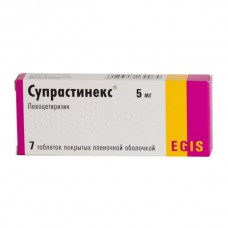Expiration date: 02/2025
The composition and form of issue:
Tablets, film-coated. 1 tablet contains:
levocetirizine dihydrochloride 5 mg
(corresponding to 4,21 mg of levocetirizine)
excipients: microcrystalline cellulose silicon Prosolv HD90 (MCC, silicon dioxide colloidal anhydrous) lactose monohydrate is 37.9 mg of hyprolose nizkosoleva (L-HPC11) magnesium stearate
the shell: Opadry II 33G28523 white (hypromellose 2910, titanium dioxide, lactose monohydrate — 1,05 mg, macrogol 3350. triacetin)
blistere in 7 or 10 PCs in a pack a cardboard 1 or 2 blisters (7 PCs.) or 1, 2 or 3 blisters (for 10 pieces).
Drops for reception inside. 1 flask contains:
levocetirizine dihydrochloride 0.1 g
(1 ml contains 5 mg levocetirizine dihydrochloride)
auxiliary substances: glycerol (85%) — 5 mg propylene glycol and 7 g of sodium saccharin and 0.2 g of sodium acetate trihydrate and 0.12 g methyl parahydroxybenzoate — 0.027 g parahydroxybenzoate — 0.003 g of acetic acid ice — 0,010 g purified water up to 20 ml
in dark glass bottles with PE dropper bottle of 20 ml in a cardboard pack 1 bottle.
Description pharmaceutical form:
Tablets, film-coated: white or almost white round biconvex, film-coated, without or almost odourless, with engraving "E" on one side and "281" on the other.
Drops for reception inside: colorless or almost colorless liquid without sediment, with a weak smell of acetic acid.
Pharmacokinetics:
The pharmacokinetics is linear. Quickly absorbed by ingestion, eating does not affect the completeness of absorption, but decreases its speed. Bioavailability is 100%. Tmax is about 0.9 h Cmax — 207 ng/ml. Vd is approximately 0.4 l/kg plasma protein Binding — 90%.
Less than 14% of the drug is metabolized in the liver by O-dezalkilirovania with the formation of pharmacologically inactive metabolite.
T1/2 of 7-10 h. Total Cl is approximately 0.63 ml/min/kg Completely eliminated from the body within 96 hours Excreted by the kidneys (approximately 85,4%). In renal failure (Cl creatinine less than 40 ml/min), clearance is decreased (in patients, on hemodialysis, 80%), T1/2 is longer. Less than 10% is removed during hemodialysis. Passes into breast milk.
Description pharmacological action:
Enantiomer of cetirizine, a competitive antagonist of histamine blocking H1-histamine receptors, the affinity for which is 2 times higher than that of cetirizine. Affects vitaminzawisimah stage allergic reactions, reduces migration of eosinophils, reduces vascular permeability, limits the release of mediators of inflammation. Warn development and facilitates the allergic reactions, has antiexudative, antipruritic effect also has anticholinergic and antiserotoninergic action. In therapeutic doses practically does not have sedative action.
The action begins 12 minutes after a single dose in 50% of patients, using 1 h — 95% and continues for 24 hours.
Indications:
Symptomatic treatment of the following conditions
- year-round (persistent) and seasonal allergic rhinitis and conjunctivitis (itching, sneezing, rhinorrhea, lacrimation, conjunctival hyperemia)
- hay fever (pollinosis)
- urticaria, incl. chronic idiopathic urticaria
- angioedema
- allergic dermatosis, accompanied by itching and rashes.
Contraindications:
- hypersensitivity to the active substance (including piperazine derivatives) or to any auxiliary component of the drug
- severe renal insufficiency (Cl creatinine less than 10 ml/min)
- children up to age 6 years (for tablets, film-coated) and up to 2 years (for drops reception inside)
- pregnancy and lactation (see "pregnancy and breastfeeding")
- lactose intolerance, hereditary lactase deficiency the Sami or malabsorption syndrome of glucose-galactose — for tablets, film-coated (see "Special instructions").
Caution: chronic renal failure, older age (may decrease glomerular filtration).
Application of pregnancy and breast-feeding:
Studies conducted on animals revealed no direct or indirect harmful effect on pregnancy, the development of the embryo or fetus, childbirth or postnatal development. Controlled clinical studies safety of the drug in pregnant women has not been conducted, so the drug should not be administered during pregnancy.
Levocetirizine is excreted in breast milk, so if necessary, taking it lactation breastfeeding the drug should be discontinued.
Side effects:
Used lower frequency of side effects is defined as follows: very often — &ge1/10 often — &ge1/100 and <1/10 uncommon — &ge1/1000 and <1/100 rare &ge1/10,000 and <1/1000 very rare <1/10000.
The immune system: very rarely — allergic including anaphylaxis.
From the metabolic: very rarely — increase of body weight.
In the Central and peripheral nervous system: often — drowsiness, headache, fatigue, rarely — asthenia rarely — headache, dizziness.
From the side of respiratory system: rarely — dyspnea.
By the blood: often — dry mouth, rarely — pain in abdomen very rare — nausea, indigestion.
From subcutaneous fat: very rarely — angioneurotic edema, skin itching, rash, hives.
From the laboratory parameters: very rare — changes in liver function tests.
Drug interactions:
Investigation of the interactions of levocetirizine showed no clinically significant interactions with pseudoephedrine, cimetidine, ketoconazole, erythromycin, azithromycin. the glipizide and diazepam. Concomitant use with macrolides or ketoconazole did not cause significant changes on the ECG.
Theophylline (dose of 400 mg/day) reduces total clearance of levocetirizine by 16%, while the kinetics of theophylline is not changed.
Levocetirizine does not enhance the effects of alcohol, however, sensitive patients the simultaneous intake of levocetirizine with alcohol or other drugs, depressing the Central nervous system, can affect the Central nervous system.
Method of application and dose:
Inside, during a meal or on an empty stomach, squeezed small amount of water without chewing. Drop measured with a dropper in a tablespoon or a glass of water, should be taken immediately after dilution.
The daily dose is recommended to take at one time.
The recommended dose for adults and children older than 6 years, elderly patients (assuming normal renal function), 5 mg (1 table. or 1 ml (20 drops) daily children ages 2 to 6 years — 2, 5 mg 2 doses in equal doses of 1, 25 mg (2 times for 0, 25 ml drops or 2 times for 5 drops)
Patients with impaired renal function. The frequency of intake should be set individually according to renal function. Patients with chronic renal insufficiency with Cl creatinine 30 to 49 ml/min the dose should be reduced in 2 times — 5 mg (1 table. or 1 ml (20 drops) a day with Cl creatinine from 10 to 29 ml/min the dose should be reduced to 3 — fold by 5 mg (1 table. or 1 ml (20 drops) every 3 days. In severe renal failure (Cl creatinine less than 10 ml/min) the drug is contraindicated.
Patients with impaired liver function. In appointing the drug to patients with isolated liver any changes dose is not required. Patients with concomitant impaired liver function and kidney dose adjustment (see above section "Patients with impaired renal function").
The duration of intake of the drug. Duration of reception depends on the disease. The treatment of hay fever in an average of 1-6 weeks. In case of chronic diseases (year-round rhinitis, chronic idiopathic urticaria) treatment can be increased. There is clinical experience with the drug prior to 18 months.
Overdose:
Symptoms in adults are manifested by drowsiness, in children, agitation, restlessness followed by drowsiness.
Treatment: symptomatic and supportive therapy, gastric lavage, the appointment activated charcoal. Hemodialysis is ineffective. There is no specific antidote.
Special instructions:
During treatment advised to refrain from the use of ethanol (see section "Interactions").
Suprastine the preparation of tablets, coated tablets contains lactose, therefore it should not be administered to patients with lactose intolerance, hereditary lactase deficiency the Sami or malabsorption syndrome of glucose-galactose.
The drug Suprastine drops for reception inside is not recommended for children under 2 years (due to the lack of data on the use of drugs). Drops can cause allergic reactions (sometimes late), since they contain methyl - parahydroxybenzoate.
Effects on ability to drive vehicles and management mechanisms. During treatment advised to refrain from activities potentially hazardous activities, require high concentration and psychomotor speed reactions.




